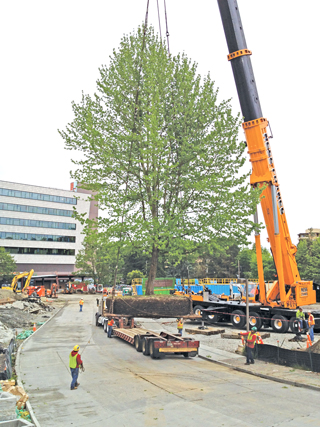|
Subscribe / Renew |
|
|
Contact Us |
|
| ► Subscribe to our Free Weekly Newsletter | |
| home | Welcome, sign in or click here to subscribe. | login |
Construction
| |
 |
April 17, 2013
A unique to-do list: move 68-ton tree and play Where’s Waldo with kids
Sellen Construction

Scalzo
|
Seattle Children’s Building Hope expansion project was memorable for many reasons. The construction team sought to make the project as enjoyable as possible, not only for those building the facility but also for the children being treated there.
From the beginning of our involvement in 2009 through the project’s completion in February, the construction team focused on building a quality facility for Children’s while helping to ensure its staff could create the best possible experience for patients and families.
During the design phase, Sellen helped Children’s build full-scale, cardboard mock-ups used by an integrated design task force (including patients, families and staff, Sellen and ZGF Architects) to incorporate everyone’s ideas into the new facility’s design.
During construction, Sellen made disruption mitigation and safety plans, and sought to engage the children as much as possible. Sellen created a Where’s Waldo? game for them by hiding a life-size mannequin dressed like the famed storybook character around the site each day, and steel workers also painted the names of children receiving treatment on exposed steel beams.
These memories, however, are only part of the construction story. The team also faced several unique challenges, many of which were central to the fabric of the new building and its site.
A tree-mendous effort
One of the most daunting and rewarding tasks involved moving and replanting 24 major trees during construction. To accomplish this, a partnership was formed with Site Workshop, Supreme Landscape Services and Tree Solutions, and this led to one of the largest tree relocations that Sellen has managed in recent history.
The trees were a collection of fully matured scarlet oak, sweet gum and maple trees. The largest was a red maple that weighed 136,000 pounds (68 tons), with others weighing between 8,000 and 130,000 pounds.
The process of relocating just one tree involved digging around the root ball (generally 9 to 20 feet in length and 5 to 8 feet deep), wrapping galvanized basketing material around the root ball, and then moving the tree by crane and flatbed trailer to a protected temporary storage area on site. The trees lived there for about two years before being replanted in their new onsite location.
Not all trees could be relocated, however. If a tree was deemed too fragile to withstand a move, it was removed and converted into another use. For example, limbs were chipped and used as mulch and the lower 30 feet of trees were converted into wall paneling and ceiling boards.
Seismic enhancements
Children’s set a goal to dramatically increase the facility’s resilience in response to any earthquake. This was important because Children’s offers critical care that isn’t available elsewhere in the five-state region, so a disruption in operations could have wide-ranging regional impacts.
To accomplish this, the building structure and its contents were designed for an enhanced level of seismic performance. Building codes focus on safety, but lessons learned from past earthquakes show that design for critical facilities needs to be operationally focused. The performance of building materials and infrastructure is vital — one broken sprinkler main could impact the entire hospital.
Building Hope is one of the first facilities in the Seattle area to implement this highly stringent seismic level, and this meant a significant learning curve for all involved. The structural engineer, Coughlin Porter Lundeen, developed a rigorous process that combined enhanced design and a three-phase inspection process to ensure nothing was overlooked. The end result is a seismically enhanced facility capable of providing care even during extreme seismic events.
New skybridge
A key element of the project is a new skybridge that connects the Building Hope expansion to the existing facility at five levels.
Ideally, the skybridge would have been built at beginning of construction. However, because the existing building was operational and construction would require patient relocations, the team approached it in two phases.
In the first phase, the team constructed the skybridge along with the expansion, building it nearly all the way out to the existing building but stopping before making the final connection. In the second phase, the team finished renovating the connections in the existing facility and joined the two buildings in fall 2012.
Doing the final connection work near completion required that Sellen bring subcontractors back on site and transport materials in smaller loads through new elevators. It also meant extensive coordination with Children’s as work occurred near sensitive areas, including a neonatal intensive care unit and an oncology unit.
The team used core-drilling techniques to mitigate vibration, scheduled work hours and construction access around the hospital’s schedule, and reviewed infection prevention plans daily.
Meeting the neighbors
The Children’s campus sits in the middle of the Laurelhurst community, and from the start Sellen and Children’s worked hard to put in place a proactive communications plan to keep the community informed.
As construction ramped up, Sellen team members went door to door to introduce themselves to the people who would be their neighbors for the next two years. During these visits, team members distributed key contact information and explained how the communication plan would keep neighbors informed.
The team also used social media tools to share project information. Sellen created and managed a Twitter account for Building Hope, and Children’s began a construction blog.
Sellen provided Children’s with a weekly construction bulletin, which was uploaded on the blog and tweeted to 189 Twitter followers. The bulletin, blog and Twitter information, as well as information about any special events or construction activities, were also posted on a project website and kiosks in central neighborhood locations.
In the end, Children’s staff, patients and visitors, as well as the entire community, now find themselves with a state-of-the-art facility, multiple neighborhood enhancements and some long-deserved quiet. Sellen is proud to have played a major role in Building Hope — a facility that is sure to live up to its name.
Dave Scalzo is a senior vice president and senior project manager at Sellen Construction. He has been with Sellen for 29 years and has built major health care facilities for many of the region’s health care providers.
Other Stories:
- Ultra-efficient mechanical systems offer lots of ways to cut costs
- How to create spaces that help children heal
- Hospital design started with yarn, cardboard and duct tape



